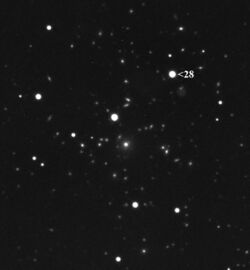Astronomy:28 Bellona
 | |
| Discovery | |
|---|---|
| Discovered by | R. Luther |
| Discovery date | 1 March 1854 |
| Designations | |
| (28) Bellona | |
| Pronunciation | /bɛˈloʊnə/[2] |
| Named after | Bellona |
| 1951 CC2 | |
| Minor planet category | Main belt |
| Adjectives | Bellonian /bɛˈloʊniən/[2] |
| Orbital characteristics | |
| Epoch Sept 30, 2012 (JD 2456200.5) | |
| |{{{apsis}}}|helion}} | 477.240 Gm (3.196 AU) |
| |{{{apsis}}}|helion}} | 353.977 Gm (2.358 AU) |
| 415.608 Gm (2.777 AU) | |
| Eccentricity | 0.151 |
| Orbital period | 1690.19 d (4.63 a) |
| Mean anomaly | 121.574° |
| Inclination | 9.430° |
| Longitude of ascending node | 144.330° |
| 344.461° | |
| Physical characteristics | |
| Dimensions | 97 ± 11 km[3] 120.9 ± 3.4 km (IRAS)[4] 108.10 ± 11.49 km[5] |
| Mass | (2.62±0.15)×1018 kg[5] |
| Mean density | 3.95 ± 1.28 g/cm3[5] |
| Rotation period | 15.706 h[4][6] |
| Geometric albedo | 0.1763[4][7] |
| S [4] | |
| Absolute magnitude (H) | 7.09[4] |
Bellona (minor planet designation: 28 Bellona) is a large main-belt asteroid. It was discovered by German astronomer R. Luther on March 1, 1854, and named after Bellōna, the Roman goddess of war; the name was chosen to mark the beginning of the Crimean War. Its historical symbol was Bellona's whip and spear; it is in the pipeline for Unicode 17.0 as U+1CECE (![]() ).[8][9]
).[8][9]
Bellona is a stony (S-type) asteroid with a cross-section size of around 100–120 km. 28 Bellona is orbiting the Sun with a period of 4.63 years.
Bellona has been studied by radar.[10] Photometric observations of this asteroid at the Palmer Divide Observatory in Colorado Springs, Colorado in 2007 gave a light curve with a period of 15.707 ± 0.002 hours and a brightness variation of 0.27 ± 0.03 in magnitude. This report is in close agreement with a period estimate of 15.695 hours reported in 1983, and rejects a longer period of 16.523 hours reported in 1979.[11]
References
- ↑ "Astrometry.net job 1005148". http://nova.astrometry.net/user_images/567142#annotated. Retrieved 6 February 2015.
- ↑ 2.0 2.1 Bellona (3rd ed.), Oxford University Press, September 2005, http://oed.com/search?searchType=dictionary&q=Bellona (Subscription or UK public library membership required.)
- ↑ Ďurech, Josef; Kaasalainen, Mikko; Herald, David; Dunham, David; Timerson, Brad; Hanuš, Josef et al. (2011). "Combining asteroid models derived by lightcurve inversion with asteroidal occultation silhouettes". Icarus 214 (2): 652–670. doi:10.1016/j.icarus.2011.03.016. Bibcode: 2011Icar..214..652D. http://astro.troja.mff.cuni.cz/projects/asteroids3D/download/durech_et_al_2011_occ_paper.pdf. Retrieved 26 January 2012.
- ↑ 4.0 4.1 4.2 4.3 4.4 "JPL Small-Body Database Browser: 28 Bellona". Jet Propulsion Laboratory. https://ssd.jpl.nasa.gov/sbdb.cgi?sstr=28. Retrieved 2012-01-28. "2012-01-02 last obs"
- ↑ 5.0 5.1 5.2 Carry, B. (December 2012), "Density of asteroids", Planetary and Space Science 73 (1): 98–118, doi:10.1016/j.pss.2012.03.009, Bibcode: 2012P&SS...73...98C. See Table 1.
- ↑ "Archived copy". http://www.psi.edu/pds/asteroid/EAR_A_5_DDR_DERIVED_LIGHTCURVE_V8_0/data/lc.tab.
- ↑ "Archived copy". http://www.psi.edu/pds/asteroid/EAR_A_5_DDR_ALBEDOS_V1_1/data/albedos.tab.
- ↑ Bala, Gavin Jared; Miller, Kirk (18 September 2023). "Unicode request for historical asteroid symbols". Unicode. https://www.unicode.org/L2/L2023/23207-historical-asteroids.pdf.
- ↑ Unicode. "Proposed New Characters: The Pipeline". The Unicode Consortium. https://unicode.org/alloc/Pipeline.html.
- ↑ "Radar-Detected Asteroids and Comets". NASA/JPL Asteroid Radar Research. http://echo.jpl.nasa.gov/asteroids/. Retrieved 2011-10-30.
- ↑ Warner, Brian D. (December 2007), "Asteroid Lightcurve Analysis at the Palmer Divide Observatory - March-May 2007", The Minor Planet Bulletin 34 (4): 104–107, Bibcode: 2007MPBu...34..104W.
External links
- Lightcurve plot of 28 Bellona, Palmer Divide Observatory, B. D. Warner (2007)
- Asteroid Lightcurve Database (LCDB), query form (info )
- Dictionary of Minor Planet Names, Google books
- Asteroids and comets rotation curves, CdR – Observatoire de Genève, Raoul Behrend
- Discovery Circumstances: Numbered Minor Planets (1)-(5000) – Minor Planet Center
- 28 Bellona at AstDyS-2, Asteroids—Dynamic Site
- 28 Bellona at the JPL Small-Body Database
 |

